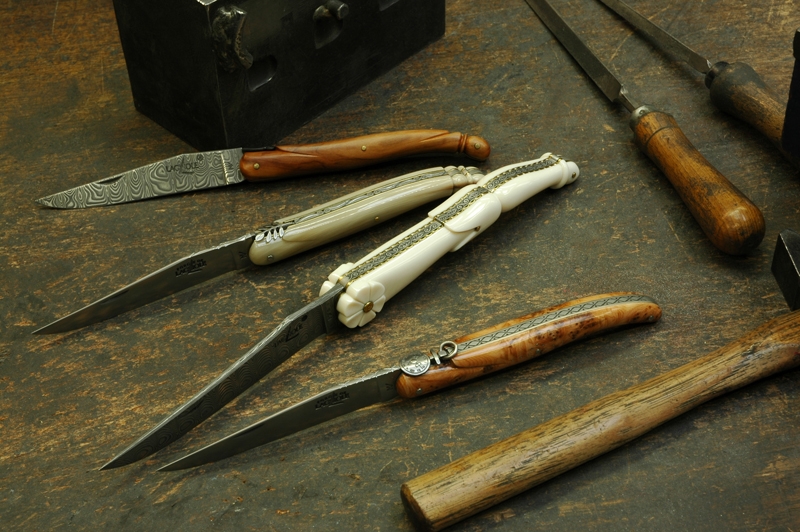Thirty years ago, a group of knife-lovers in southern France were worried that the skills for making their traditional knives were going to be lost. After all, who still cared about bone-handled hunting knives once used by traveling shepherds in Spain? Apparently, Philippe Starck did. As did the French government, which recognized that these were irreplaceable treasures. So with their help, this little group of artisans started a thriving business making these knives.
In an era of mass-market production, this seemed like an impossible dream, but through the efforts of those folks, today this company – Forge de Laguiole – makes the highest-quality Laguiole implements in the world. And every piece is completely made, from beginning to end, in the place where it all started: the original village of Laguiole.

If you’re ever in southern France (perhaps to visit Michel Bras’s three-Michelin starred restaurant), schedule a tour of Forge de Laguiole’s headquarters. Once there, you’ll come face to face with master knife makers, breathe in the scent of the raw materials used to make these pieces, and hear the sound of sandpaper as it’s passed back on forth on each piece.

The building, by uberdesigner Philippe Starck, is unlike any other in the whole region. Tasked with creating a space which reflected the founders’ goals of combining tradition with innovation, Mr. Starck designed a building which uses glass and aluminum and features a 60-ft tall blade soaring into the sky.

There, you’ll be met by folks just like these; folks who’ve spent a lifetime making knives.

But not just any knives: these are the cult-favorite Laguiole knives, synonymous with French art de vivre and gastronomy.

Inside, you’ll learn that Laguiole is not a brand or even a trademark; rather, laguiole refers to a classic style of knife featuring a slim, sinuous shape common to this area. Each laguiole knife is about 5 inches long when closed, with a narrow, tapered blade, a steel backspring, and high-quality construction.
Laguiole knives originated from the “navajas” used in Andalusian Spain, which were brought over by shepherds and cattle herders moving between Spain and southern France. In Spain, these navajas appeared around the late 1600’s, when there were increased restrictions on the wearing of bladed weapons by persons outside the Spanish nobility. So the intrepid locals designed something that could be used both as a utility and a fighting knife.

Over time, the design of the navajas merged with those of local French folding knives, resulting in the classic laguiole. Later, some models began featuring corkscrews, in response to the introduction of bottled wines and the needs of bar owners to work quickly during mealtimes.

In France, laguiole production is centered around the town of Thiers and the village of Laguiole, both located around 100 miles apart in southern France. Together, this region accounts for 70% of the cutting tool production in France, so it is deeply steeped in the tradition of French knife manufacturing.
Traditionally, Laguiole handles were made from cattle horn, but now many other precious materials are used, including exotic woods, horn, pearl, and fossilized ivories. Here’s a elegant version featuring a rosewood handle.

In 1988, French designer Philippe Starck designed a knife for Forge de Laguiole with a polished aluminum handle and a corrosion-resistant steel blade which made waves around the world. Today, this knife is part of the permanent collection of the Museum of Modern Art in New York.

Quality Laguiole knives are very time-consuming to make. There are approximately 109 production steps required to make a one-piece laguiole (single blade), about 166 for a two-piece one (blade and one other tool), and about 216 for a three-piece model (blade and two tools).
French manufacturers stamp a trademark or signature into the steel of their knives. In addition, they are often decorated with a variety of motifs. In 1909, the village of Laguiole agreed that the bee would be their sign. As the legend goes, the bee was a sign of honor, given to soldiers for their bravery.

For special commissions, other motifs can be carved, like this custom violin.

Laguiole knives are more than just knives: they are handcrafted expressions of a way of life.

When you’re done, get back in your car and head to the nearest bar. Where, if the service is slow, you’ll be able to open your own bottle of wine!

Comments
2 responses to “Returning to Laguiole … the Birthplace of the Classic French Pocket Knife”
I have what appears to be a couple of forge de laguiole steak knifes but they don’t have any marks . The quality is certanily in the knifes.
Yes, definitely!